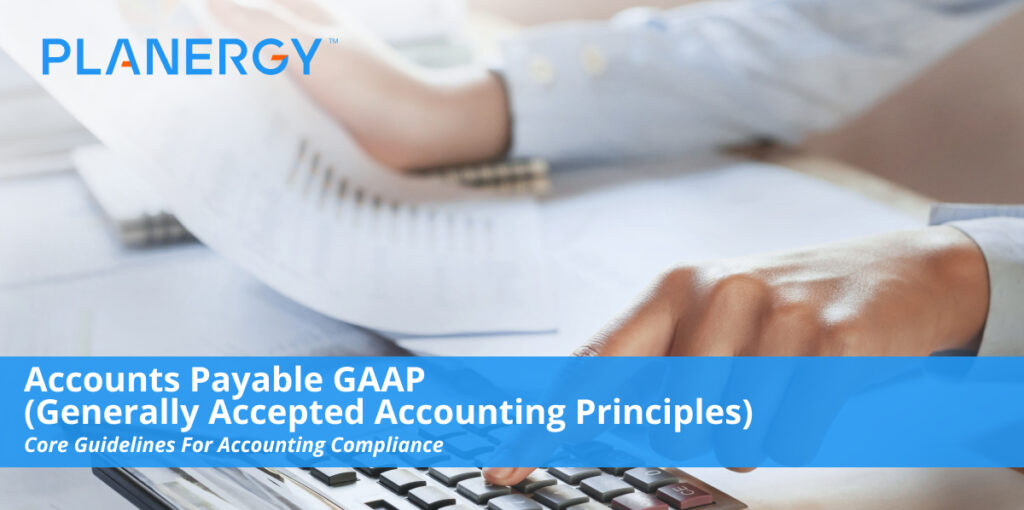No matter what line of business you’re in, adhering to the Generally Accepted Accounting Principles (GAAP) for your accounting department—both in general and for accounts payable (AP) specifically—is essential to accurate financial statements and legal compliance.
Depending on the type and size of your business, you’ll likely have both an overarching set of principles to follow and ones specific to your industry.
Regardless, understanding the best practices and legal requirements that come with GAAP and other accounting principles will help you optimize your workflows, generate useful, clear, and accurate financial data, and stay on the right side of the law.
The Importance of Accounts Payable GAAP and The Three Rules
Every accounts payable department using double entry, accrual-based accounting follows a version of GAAP (cash-basis accounting is not GAAP-compliant).
The Generally Accepted Accounting Principles are a set of specific rules and processes specific to the United States, designed to provide oversight for accounting practices for for-profit public companies, government accounting, and non-profit organizational accounting.
In the United States, GAAP was developed by the Financial Accounting Standards Board (FASB) and the Governmental Accounting Standards Board (GASB).
Under US law, all publicly-traded companies must follow U.S. GAAP. This also applies to any company that publicly releases its income statement and any other financial documents.
Born in the wake of the Great Depression and the passage of the Securities Act of 1933, GAAP is built on 10 primary principles designed to establish and enforce honest, forthright, and complete financial reporting practices:
- Consistency. Standards are applied consistently throughout the entire financial reporting process.
- Permanent Methods. All financial reports are prepared in a consistent and permanent manner.
- Sincerity. Accountants following GAAP are dedicated to complete accuracy, impartiality, and transparency.
- Regularity. All accounting practices and financial reporting are performed with strict adherence to established rules and regulations.
- Non-Compensation. Positive or negative, all aspects of an organization’s performance are fully reported without the possibility of debt compensation.
- Prudence. Financial data is untainted by speculation.
- Continuity. Asset valuations are assigned with the assumption the organization will continue to operate for the foreseeable future.
- Periodicity. Financial reporting is performed at standard accounting intervals, e.g. fiscal quarters or years.
- Materiality. Reports are absolutely transparent and fully disclose the organization’s financial health and position.
- Utmost Good Faith. All parties involved in financial reporting are acting honestly, with integrity, and in good faith.
By requiring businesses, non-profits, and government organizations to be clear and honest with their financial reporting, GAAP makes it easier for investors (as well as senior management, government agencies, and other stakeholders) to make informed decisions when reviewing an organization’s financial information.
Some US companies operate under practices set by the International Financial Reporting Standards (IFRS) instead of, or in addition to, GAAP. The IFRS also covers accounting standards for the European Union and various countries located in Asia and South America.
By requiring businesses, non-profits, and government organizations to be clear and honest with their financial reporting, GAAP makes it easier for investors and key stakeholders to make informed decisions when reviewing an organization’s financial information.
The Three Rules
Each of GAAP’s 10 guiding principles is informed and guided by three overarching rules.
Created to prevent accountants from either intentionally or accidentally creating a misleading view of an organization’s financial position, the three rules help protect both the public and the organizations themselves from inaccurate or fraudulent financial data.
- Basic Accounting Guidelines and Best Practices. Following the guidelines ensures:
- Organizational transactions are separate from those of the owner(s).
- Currency, accounting time periods, and other data are clear and consistent.
- Best practices for cost management, financial disclosure, revenue recognition, professional judgement, matching, etc. are followed.
- FASB Standards and Rules Are Followed. Organizations adhere to the continuously evolving FASB standards for best practices.
- Generally Accepted Industry-Specific Practices Are Enforced. Different organizations have very different in-depth and specific accounting practices, based on their particular structure and legal standing. For example, a government agency, a bank, and a non-profit foundation would all adhere to GAAP principles, but have their own unique set of accounting and financial reporting requirements.
GAAP in Accounts Payable
No two companies have the same exact set of internal best practices for AP, but bookkeeping standards that adhere to GAAP are generally built on a common foundation. In accounts payable, ensuring transparency and integrity of financial data is tied to several processes subject to internal controls, including but not limited to:
- Expense Account Reimbursements. Employees follow clear and well-documented procedures for submitting reimbursement requests. Receipts and other documentation are included, and all requests within certain limits are routed for approval before payment can be issued.
- Coding Expenses. Every vendor invoice and request for payment must include the proper expense code to be paid.
- Vendor Qualification. Every supplier must be carefully vetted before they can be added to the company’s accounting system.
- Data Entry. All transaction information must be properly recorded in the accounting system, verified against related documentation (e.g., a three-way match between a vendor invoice, purchase order, and receiving documents for a specific order), and recorded clearly and completely using the proper journal entries.
- Check Production. Payments are issued, either by paper check or electronically, once a report of all outstanding items requiring payment has been reviewed and approved. Exceptions are returned for further review. Approved items are routed for final payment.
Traditionally, all of these processes were done manually, on paper, at whatever pace the staff members in question could reasonably manage.
Today, companies eager to enhance their productivity and competitive performance along with their adherence to GAAP are prioritizing an additional best practice: AP automation.
By implementing a complete AP automation solution like PLANERGY, it’s much easier to document, automate, and streamline GAAP-friendly practices. By automating, AP teams can:
- Eliminate the need for manual, paper-based workflows.
- Increase the speed and accuracy of low-level, high-volume tasks.
- Free humans from repetitive, tedious tasks such as data entry while eliminating related human errors, along with the time and resources necessary to correct them.
- Implement automatic three-way matching and expense coding.
- Smarter approval workflows with built-in contingencies to eliminate bottlenecks that create needless expense due to late fees and penalties.
- Simplify vendor onboarding, including automatic population of tax information and contract-specific payment terms.
- Digital invoicing and payment for faster payments, better vendor relationships, and more discounts captured.
- Provide total data transparency and completeness, ensuring an accurate balance sheet, clear oversight of working capital, and optimal data for financial analysis and reporting.
For Optimal AP, Mind the GAAP
By adhering to the generally accepted principles of accounting, organizations can insulate themselves from needless risk and potential legal troubles while simultaneously providing accurate and crystal-clear financial reporting.
And by making automation part of your best practices, your AP can team streamline their workflows for faster payments, easier cash flow management, and more strategic spending in concert with procurement.




